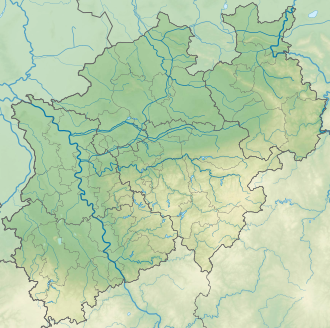Dörenschlucht
| Dörenschlucht | |||
|---|---|---|---|
|
In the Dörenschlucht |
|||
| region | Circle lip | ||
| Mountains | Teutoburg Forest | ||
| map | |||
|
|
|||
| Coordinates | 51 ° 55 '54 " N , 8 ° 45' 55" E | ||
The Dörenschlucht is a mountain pass in the Teutoburg Forest between the Detmold district Pivitsheide VL , Augustdorf and the Lagens district Hörste in the Lippe district . Dören (also Döhren) denotes a pass through a mountain range in the Low German-speaking area , especially in East Westphalia-Lippe . The origin of the term can be traced back to the Low German Dör (door).
The Dörenschlucht is surrounded in the southeast by the Großer Ehberg (339.6 m), in the northwest by the Kleiner Ehberg (217.4 m) and in the west by the Hörster Berg (315.1 m). In the south is the Senne landscape with the Senne military training area and Field Marshal Rommel Barracks in Augustdorf.

The gorge was formed by the melting of a glacier in the Drenthe stage of the Saale Ice Age , which stretched through the Porta Westfalica and cross valleys of the Wiehengebirge from the northeast to the Teutoburg Forest. Its meltwater flowed over the passes to the southwest and carried large amounts of sand with it, which were deposited in the lower plain, the Senne. In addition to the Dörenschlucht, this process took place in the nearby Stapelager Schlucht , the Oerlinghauser Pass and the Bielefelder Pass . A 26.07 ha part of the gorge is designated as the Dörenschlucht nature reserve (LIP-023). This is where, for example, the springs of the Rethlager stream are located .
In the Dörenschlucht gorge there are traces of early human settlement at the Rethlager springs. These are hut layouts from the Mesolithic between around 8000 and 5000 BC. BC, which were discovered and excavated by Heinrich Schwanold at the beginning of the 20th century . There are also a number of barrows from the older Bronze Age in the gorge . The pass was also used for traffic early on. The old trade route Frankfurter Weg or Weinstrasse led from Frankfurt am Main to Bremen or Lübeck through the Dörenschlucht gorge. The two branches of the Westphalian Hellweg on both sides of the Teutoburg Forest were also connected by the gorge. At the narrowest point of the Dörenschlucht gorge there are the remains of a presumably late medieval Landwehr which was used to control the paths.
Ferdinand Freiligrath located the Varus Battle in the Dörenschlucht when he praised the choice of the location of the nearby Hermann monument.
In the Dörenschlucht there is a small military cemetery, which testifies to a battle in the last days of the Second World War . A unit of the Waffen SS had holed up here to stop the advance of the American troops. After seven American Sherman tanks were shot down, they had to retreat to the nearby quarry, where 35 members of the Waffen SS and an unknown number of Americans lost their lives.
Today Augustdorfer Straße (Landesstraße 758) runs along the gorge and the supraregional Roman route cycle path crosses the Teutoburg Forest here.
Individual evidence
- ↑ Page no longer available , search in web archives: Information from the Geological Service of North Rhine-Westphalia on the Day of the Geotope 2005
- ↑ Helmut Luley: Mesolithic residential huts at the Retlager sources. An important building block in Central European research on prehistory - messages from Lippe history and regional studies, No. 51, 1982, pp. 17-20 digitized
- ↑ Ernst Probst, excerpt from: Records of primeval times, 1992, Archeology News (blog) ( Memento from March 28, 2008 in the Internet Archive )
- ^ A b Friedrich Hohenschwert : Der Kreis Lippe II - Guide to archaeological monuments in Germany, Stuttgart 1985, ISBN 3-8062-0428-4
- ↑ Charlotte Tacke: Monument in the social space. National symbols in Germany and France in the 19th century. Vandenhoeck and Ruprecht, Göttingen 1995, p. 65 ( digitized version in the Google book search).
- ↑ Georg Eisenhardt: April 4, 1945 - the "zero hour" in Detmold? In: Detmold in the post-war period (= special publications of the Natural Science and Historical Association for the Land of Lippe ). tape 41 . Aisthesis Verlag, Bielefeld 1994, ISBN 3-925670-94-7 , p. 50 .
- ^ German artillery - Artillerie-Gesellschaft-Augustdorf e. V .: The garrison and the history of the military facilities around the Augustdorf site. Retrieved June 20, 2014 .




